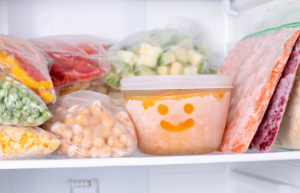Freezing food is a method of preserving food. The process is helpful for many purposes and has been used by farmers and trappers since early. Today, it is also used by fishermen.
 Origins
Origins
One of the most popular ways to preserve food is to freeze it. There are various ways to do it, including mechanical, electrical, and chemical. However, freezing is more complex a process than it may seem.
While the concept of freezing has been around for centuries, it was not until the invention of the freezer that it took on new life in modern times. Then, it was a technological advancement that revolutionized food preparation and storage.
The first commercial freezing operation was established in Darling Harbour, Sydney, Australia, in 1868. By the end of the nineteenth century, the freezing process had been refined to the point where it was possible to freeze a meat cargo and ship it to London.
The process had its problems, though. A slow freeze resulted in a lot of water being well-spent. In the end, this venture failed miserably.
Mechanical properties
Food freezing is a process commonly used to preserve food for extended periods. This process can reduce food waste and give consumers a longer shelf life. However, maintaining frozen food characteristics requires proper handling and packaging.
Markwell Foods frozen food physical and chemical properties are essential in designing and evaluating food-freezing processes. In particular, they determine the stability of the product. In addition, it is easier to predict the shelf life of frozen food by considering these properties. Therefore, obtaining quantitative information on food properties is a must.
A fundamental property of interest in food freezing is thermal diffusivity, which relates to the speed of heat conduction in the material. The thermal conductivity coefficient depends on the material’s density and structure.
Another property of interest in food freezing is specific heat. The specific heat of a solid at a given temperature is a function of the material’s thermal diffusivity and chemical composition.
At temperatures below T’g, frozen food’s deterioration rate is relatively slow. But with increasing temperatures, the rate of decay increases significantly.
Temperature is also a factor in the formation of ice crystals. Large ice crystals cause permanent cell damage, altering the texture and firmness of foods. On the other hand, tiny ice crystals do not cause cell damage but reduce texture deterioration.
Ice crystals can also alter the physical structures of tissues. For example, large ice crystals can form cell walls that rupture, causing irreversible turgor loss. These crystalline structures can also cause structural changes in fruits and vegetables.
Safety
Markwell Foods frozen food products can become contaminated with pathogens when stored improperly. Therefore, manufacturers must ensure proper refrigeration, cleaning equipment, and procedures to prevent microbiological spoilage.
Listeria monocytogenes is a particularly concerning microorganism. It has been linked to outbreaks across the world. People at risk for listeriosis are children, pregnant women, and people with chronic illnesses.
A nationwide recall was issued for IQF peas and corn in the United States in 2017. In addition, Tyson Foods voluntarily recalled 8.5 million pounds of frozen RTE chicken products in 2021. In addition, the United States Food and Drug Administration (FDA) pursues a zero-tolerance policy for L. monocytogenes in foods, which is ineffective in mitigating pathogens in low-risk foods.
The European Union (EU) has microbiological criteria for Listeria monocytogenes of 100 CFU/gram for low-risk foods. Some retail markets have implemented coronavirus tests before imported seafood.
Despite these precautions, several recalls have been conducted in recent years for contaminated frozen foods. For instance, Nestle Prepared Foods has changed its cooking instructions for several brands.
As a result, many frozen food companies are adopting more rigorous sanitation practices. They are also ensuring that their products are packaged hygienically.
However, many actors in the supply chain still do not understand the implications of freezing and temperature abuse. As a result, while these companies work to make frozen food safer, many challenges remain.
To combat the growth of pathogens, manufacturers must implement science-based and risk-based approaches. It includes investing in refrigeration and electrical systems that can withstand rigorous cleaning.
Besides, frozen food companies are also instituting other strategies to avoid disease transmission. For example, in 2018, China strengthened supervision for imported frozen foods.